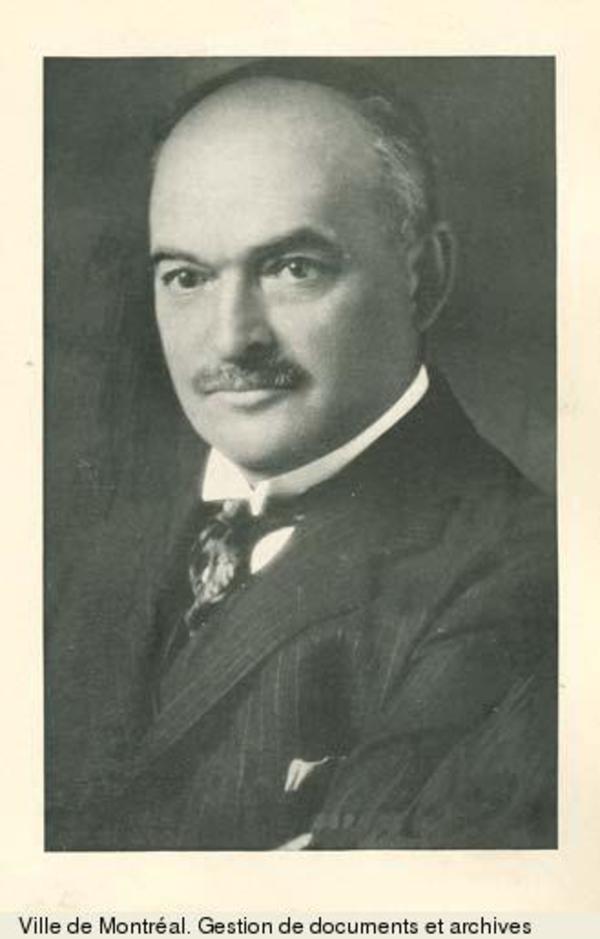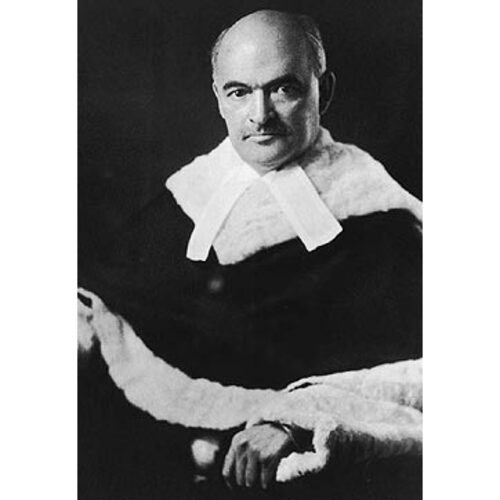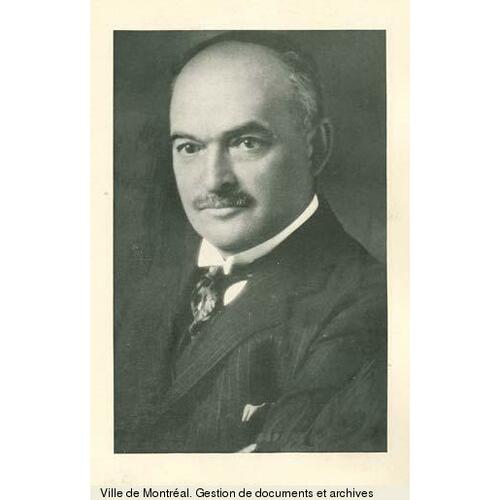
Source: Link
CANNON, Lawrence ARTHUR (baptized Laurent Arthur Dumoulin, sometimes called Arthur), lawyer, politician, and judge; b. 28 April 1877 in the parish of Saint-Christophe-d’Arthabaska, Que., son of Lawrence John Cannon*, a lawyer, and Marie-Hermine-Aurélie-Alida Dumoulin; m. 20 April 1904 Corinne Fitzpatrick in Ottawa, and they had five children; d. there 25 Dec. 1939 and was buried three days later in Notre-Dame de Belmont cemetery in Sainte-Foy (Quebec City).
Lawrence Arthur Cannon began his studies at the Collège Commercial du Sacré-Cœur in Arthabaskaville (Victoriaville), Que., and then, from 1888, attended the Petit Séminaire de Québec, from which he graduated in 1896. A brilliant pupil, he won several prizes, including the Prince of Wales Medal for rhetoric in 1894. He subsequently enrolled at the Université Laval in Quebec City; in 1899 he earned a law degree with high honours and, jointly with a fellow student, was awarded the Prix Tessier silver medal. In July he sat the examination of the bar of the province of Quebec, to which he was called the following month.
Cannon’s law career flourished. From 1899 he practised in Quebec City. He joined a firm that at the time included several jurists and politicians: Charles Fitzpatrick*, his future father-in-law; Ferdinand Roy, who would be appointed to the bench; Simon-Napoléon Parent*, then mayor of Quebec, and Louis-Alexandre Taschereau*, both future premiers of the province. Until 1927 he was to remain in practice with various associates, among them his son Charles-Arthur, who would be elected an mp. In 1911 he was named a kc. Twelve years later he became one of the three members of the commission charged with revising and consolidating the general statutes of the province of Quebec, which submitted its findings two years later. In 1924 and 1925 he was elected bâtonnier of the bar for the judicial district of Quebec City. He was active in the Canadian Bar Association and was its honorary secretary in 1927.
Over the course of his career Cannon collaborated on a number of well-publicized cases. In 1913 and 1914 Benjamin Ortenberg hired him to participate in his legal proceedings against the notary Jacques-Édouard Plamondon*, following comments made by the latter about the Jewish community [see Samuel William Jacobs]. In 1916, with Taschereau, Cannon represented Georges‑A. Vandry and insurance companies, first in the Supreme Court of Canada and then, in 1920, before the Judicial Committee of the Privy Council in London, in the case of Quebec Railway, Light, Heat and Power Company Limited v. Vandry and Others. The judgement in this case would establish a legal precedent in the province of Quebec that stood for several years and contributed to developing the interpretation of article 1054 of the Civil Code of Lower Canada, which concerns custodial responsibility for something causing damage. In 1925 Cannon joined a team of lawyers representing the city council of Quebec before the board of inquiry on the management of municipal affairs, chaired by Judge Blaise-Ferdinand Letellier. The public hearings were stormy and received wide media coverage. From 1925 to 1927 Cannon took part in arguing the case of the Province of Quebec and the Quebec Harbour Commission before the Board of Railway Commissioners for Canada. In 1927 the board decided to standardize railway rates across the various regions of the country for the transport of grain for export by the national carriers. In so doing, it ruled in favour of the applicants, whose position was supported by other interested parties throughout the country. Among other things, the board’s action stimulated the shipment of a part of the wheat trade through the port of Quebec City.
Besides participating in these activities, Cannon had stood as a candidate for councillor in the Quebec municipal elections of 1908. Chosen as one of the representatives from Palais ward, he retained his seat until 1916. He was a member of several municipal committees, notably the one on by-laws (it became the police and by-laws committee in 1911), on which he sat for all his terms as councillor. He was chair of the finance committee and acted as leader of the municipal council throughout the administration of Mayor Napoléon Drouin (1910–16). Cannon was also involved in various cultural and economic undertakings designed to promote the provincial capital. In 1910 he joined the provincial exhibition committee. He was first vice-president in 1917 and, in the absence of the president, inaugurated the festivities; he was president the following year.
In 1916 Cannon had become an mla for the riding of Quebec Centre for the Liberal Party, led by Premier Sir Lomer Gouin*. Returned by acclamation in 1919, he would be defeated less than four years later by physician Pierre-Vincent Faucher in a fiercely contested election. As an mla he served on various standing committees, including those that dealt with miscellaneous public and private members’ bills and the Municipal Code. He sometimes made no secret of his opinions and was not afraid of controversy. In 1916, in a speech that drew on his understanding of Christian values, he supported measures taken by his brother Lucien, mla for Dorchester, to allow women to be called to the bar. After conscription became an issue, he declared himself opposed to Joseph-Napoléon Francœur’s notice of motion, which advocated the withdrawal of the province of Quebec from confederation [see Gouin], and asserted the predominant place of Quebec within Canada.
Some of Cannon’s speeches and actions revealed an interest in social issues. He pressed for better salary terms for civic employees and encouraged the development of technical schools across the province. He likewise hailed certain achievements of the Gouin and Taschereau governments (the latter in power since 1920), such as the announcement of the creation of a museum of natural history in Quebec City in 1922. Throughout his political career Cannon held the Liberal Party in high regard. On several occasions he demonstrated his admiration for the former prime minister, Sir Wilfrid Laurier*, and his desire to emulate him.
Cannon had a few political adversaries, one of whom was the Conservative Camilien-Joseph Lockwell, a real-estate agent and Quebec municipal councillor from 1908 to 1916. According to historian Robert Rumilly*, the competition between the Dorchester Electric Company (supported by Mayor Drouin and several of his councillors, including Cannon) and the Quebec Railway, Light, Heat and Power Company (backed by Lockwell [see Sir Rodolphe Forget*]) was reportedly one of the causes of the antagonism between them. Lockwell would also become a powerful supporter of Faucher in the provincial election of 1923.
Cannon acceded to the judiciary in October 1927, when he was appointed to the Quebec Court of King’s Bench. His stay there was brief. In 1930 he became a judge on the Supreme Court of Canada, replacing Pierre-Basile Mignault*. He attached great importance to the law, evidence, logic, and rhetorical rigour. His knowledge of legal doctrine was manifest. Cannon knew the law well and was interested in the interpretation that could be made through jurisprudence as well as other interpretations. He occasionally ventured opinions that dissented from those of his colleagues.
As a judge Cannon displayed some of the concerns that had distinguished his career path. His opinion in the judgement Reference re legislative powers as to regulation and control of aeronautics in Canada, while acknowledging the importance of adapting the content of the British North America Act to new circumstances, clearly set out his interpretation of the division of powers between the federal and provincial governments when no defined authority was provided for in law. He also seems to have retained an interest in social issues. The grounds for his decision in Society Brand Clothes Ltd. v. Amalgamated Clothing Workers of America testify to the attention he paid to the question of the legal status of trade unions. In this context, Cannon saw a need to update article 79 of the Code of Civil Procedure of Quebec, which governed the acknowledgement, relating to unincorporated entities, of the ability to sue or be sued in their own name.
In order of age Cannon soon found himself third in the ranks of the seven judges of the Supreme Court. In 1936 Governor General Lord Tweedsmuir [Buchan] appointed him deputy governor general. In the absence of his elders on the court, Cannon acted as administrator of Canada on a few occasions in 1937. He was awarded two honorary doctorates, one by the Université Laval in 1927 and the other by the University of Ottawa in 1935, the year in which he also received the King George V Silver Jubilee Medal.
Cannon demonstrated various interests over the years. He was a member of, among others, the Institut Canadien de Québec, the Knights of Columbus, the Alliance Nationale, and golf clubs. He was also one of the directors of the Industrial Life Insurance Company and the Compagnie Maritime et Industrielle de Lévis.
His health, however, was deteriorating. He wrote few judicial decisions during the year 1939. Although he was present in May when the foundation stone of the new Supreme Court building was laid, illness confined him to his house during the last weeks of his life. Cannon died on 25 December. His impressive funeral took place in Ottawa two days later; his remains were taken to Quebec City for a final tribute at Notre-Dame basilica before he was buried.
The accounts about Cannon published in Le Soleil on 26 December emphasized his intelligence and the quality of his work, his “dignified and very regular” life, and his “most worthy ambition.” They recalled his erudition and his marked interest in literature. Similarly, they praised his profound knowledge of the law of the province. Taschereau, a long-time friend and associate, stressed his affection for his wife and his children: Charles-Arthur, with whom he had practised law; Edward Lawrence, a businessman; Alexandre, an army captain; Marie-Louise, who would marry Jules C. Notebaut of New York City; and Arthur Ernest, who was to lose his life in World War II.
A loyal man, Lawrence Arthur Cannon always demonstrated his commitment to those closest to him, his faith, his party, and the city of Quebec. His political speeches revealed an orator of some talent who used precise terms. Fond of verbal jousting, Cannon could also, on occasion, arouse emotion. A number of his statements show his concern for equality among individuals and between the federal and provincial governments. A lawyer, politician, and judge with a penetrating and sometimes-incisive mind, tenacious, able to demonstrate openness, respectful of the duties of his offices, and aware of the realities of his time, Cannon was a worthy servant of justice and of those answerable to the law.
AVQ, QA1, 7/1043. BANQ-MCQ, CE402-S2, 29 avril 1877. FD, Cathédrale Notre-Dame (Québec), 28 déc. 1939; Sainte-Agnès (Donnacona, Québec), 10 mai 1939; Saint-Joseph (Ottawa), 19 avril 1904. Le Devoir, 26 déc. 1939. La Presse, 26 déc. 1939. Le Soleil, 23 déc. 1922, 26 janv. 1923, 29 août 1927, 26 déc. 1939. Canada Gazette, 29 Oct. 1927: 1242; 25 Jan. 1930: 2671; 13 June 1936: 3044. F.‑X. Chouinard et al., La ville de Québec: histoire municipale (4v., Québec, 1963–83), 4. L.‑M. Côté et al., Les maires de la vieille capitale (Québec, 1980). Raymond Deraspe, “Le généalogiste juriste: grand juriste d’une famille de juristes,” L’Ancêtre (Québec), 33 (2006–7): 161–64. François Drouin, Législature de Québec, 1867–1950: députés et candidats selon l’ordre alphabétique (Québec, 1950). Clarence Hogue et al., Québec: un siècle d’électricité (Montréal, 1979). J.‑J. Lefebvre, “Tableau alphabétique des avocats de la province, 1868–1899,” La Rev. du Barreau de la prov. de Québec (Montréal), 22 (1962): 346. Que., The revised statutes of the province of Quebec … (Quebec City, 1925); Assemblée Nationale, “Journal et débats”: www.assnat.qc.ca/fr/travaux-parlementaires/journaux-debats.html (consulted 26 April 2017). Quebec City, Treasurer of the City of Quebec, Annual report (1907–8). Quebec Official Gazette, 1909: 1089–90; 1911: 383. Quebec Railway, Light, Heat, and Power Company, Limited, v. Vandry (1919–20), Times Law Reports (London), 36: 296–301. Reference re Legislative Powers as to Regulation and Control of Aeronautics in Canada, [1930] Supreme Court Reports (Ottawa): 663–720. P.‑G. Roy, Les juges de la prov. de Québec. Rumilly, Hist. de la prov. de Québec. Six années d’administration: son honneur Napoléon Drouin, maire de Québec, 1er mars 1910–1er mars 1916 (Québec, 1916). Society Brand Clothes Ltd v. Amalgamated Clothing Workers of America, [1931] Supreme Court Reports (Ottawa): 321–30. Univ. Laval, Annuaire, 1896–97; 1899–1900. Marc Vallières et al., Histoire de Québec et de sa région (3v., Québec, 2008). Who’s who in Canada, 1938/39.
Cite This Article
Jacinthe Plamondon, “CANNON, LAWRENCE ARTHUR (baptized Laurent Arthur Dumoulin),” in Dictionary of Canadian Biography, vol. 16, University of Toronto/Université Laval, 2003–, accessed December 29, 2025, https://www.biographi.ca/en/bio/cannon_lawrence_arthur_16E.html.
The citation above shows the format for footnotes and endnotes according to the Chicago manual of style (16th edition). Information to be used in other citation formats:
| Permalink: | https://www.biographi.ca/en/bio/cannon_lawrence_arthur_16E.html |
| Author of Article: | Jacinthe Plamondon |
| Title of Article: | CANNON, LAWRENCE ARTHUR (baptized Laurent Arthur Dumoulin) |
| Publication Name: | Dictionary of Canadian Biography, vol. 16 |
| Publisher: | University of Toronto/Université Laval |
| Year of publication: | 2019 |
| Year of revision: | 2019 |
| Access Date: | December 29, 2025 |




